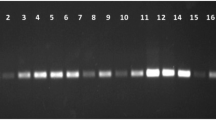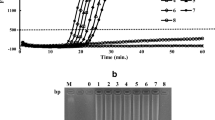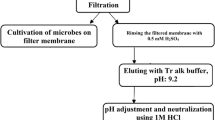Abstract
Various isolation and serological techniques were compared for the detection ofErwinia carotovora subsp.atroseptica (Eca) andE. chrysanthemi (Ech) in cattle manure slurry containing c. 108 colony forming units (cfu) per ml. The slurry samples could be preserved at −80°C for 8 months without reduction in the number of bacteria but not at −20°C. Samples stored at −80°C were inoculated with concentrations of the target bacterium ranging from 102 to 108 per ml. Only immunofluorescence colony-staining (IFC) in combination with selective media was able to detect the target organism at a concentration of 100 cells per ml. No IFC-positive colonies were found in pour plates of the non-inoculated cattle slurry. The recovery of the target bacterium from slurry inoculated with 102 cfu of Ech per ml was 64% in PT medium (containing polygalacturonic acid) and 19% in crystal violet pectate medium (CVP). Recoveries of Eca were 32% and 82%, respectively. Ech and Eca could be detected at levels of 103 cfu per ml of slurry by isolation on CVP. Crude filtration procedures were necessary for analysis of slurry samples with immunosorbent immunofluorescence (ISIF) cell staining. The detection level of ISIF for Ech was 105 cells per ml of slurry. IF-positive cells were incidentally observed in the non-inoculated slurry. Detection of Ech and Eca with ELISA was only possible in slurry inoculated with 108 cells of the target bacterium per ml.
Samenvatting
Verschillende isolatie- en serologische methoden werden vergeleken om de doelbacteriënErwinia carotovora subsp.atroseptica (Eca) enE. chrysanthemi (Ech) aan te tonen in runderdrijfmest met een natuurlijke bacterieflora van ca 108 kolonievormende eenheden(cfu) per ml. De mestmonsters konden gedurende de onderzoekperiode tenminste 8 maanden bij −80°C worden bewaard zonder dat er een afname van het aantal levende mestbacteriën werd geconstateerd, terwijl bij bewaring bij −20°C wel een afname werd gevonden. De ontdooide mestmonsters werden geïnoculeerd met de doelbacterie in concentraties tussen 102 en 108 per ml. De laagste concentratie van de doelbacterie, 102 cfu per ml, kon alleen worden aangetoond met de immunofluorescentie-kleuring van bacteriekolonies (IFC) in een selectief medium. Met deze techniek was het percentage herisolatie vanuit drijfmest geïnoculeerd met 102 Ech cfu per ml respectievelijk 64% in PT-medium (bevat polygalacturonzuur) en 19% in kristalviolet pectine medium (CVP). Voor Eca bedroegen deze percentages respectievelijk 82% en 32%. In de niet-geïnoculeerde mestmonsters werden geen IFC-positieve kolonies gevonden. Via isolatie op CVP konden 103 of meer cfu van Eca en Ech worden aangetoond. Ruwe filtratie van de mestmonsters was nodig voor het aantonen van Eca- en Ech-cellen met immunoadsorptie immunofluorescentie microscopie. De detectiedrempel lag voor deze techniek op 105 bacteriecellen per ml mestmonster. In niet-geïnoculeerde mest werden incidenteel IF-positieve bacteriën gevonden. Het aantonen van Ech en Eca met ELISA was slechts mogelijk in mest geïnoculeerd met 108 of meer cellen van de doelbacterie per ml.
Similar content being viewed by others
References
Allen, E. & Kelman, A., 1977. Immunofluorescent stain procedures for detection and identification ofErwinia carotovora var.atroseptica. Phytopathology 67: 1305–1312.
Becton & Dickenson, 1985. Microbiologisches Handbuch. Becton and Dickenson Deutschland, Heidelberg.
Burr, T.J. & Schroth, M.N., 1977. Occurrence of soft-rotErwinia spp. in soil and plant material. Phytopathology 67: 1382–1387.
Calcott, P.H., 1978. Freezing and thawing microbes. Dunham.
Clark, M.F. & Adams, A.N., 1977. Characteristics of the microplate method of enzyme-linked immunosorbent assay for the detection of plant viruses. Journal of General Virology 34: 475–483.
Cuppels, D. & Kelman, K., 1974. Evaluation of selective media for isolation of soft-rot bacteria from soil and plant tissue. Phytopathology 64: 468–475.
Hohmann, A., LaBrooy, J., Davidson, G.P. & Shearman, D.J.C., 1983. Measurement of specific antibodies in human intestinal aspirate: Effect of the protease inhibitor phenylmethylsulphonyl fluoride. Journal of Immunological Methods 64: 199–204.
Ingram, M. & Mackey, B.M., 1976. Inactivation by cold. In: Skinner, F.A. & Hugo, W.B. (Eds), Inhibition and inactivation of vegetative microbes. London 1976. Pp. 111–151.
Janse, J.D. & Spit, B.E., 1989. A note on the limitations of identifying soft rot Erwinias by temperature tolerances and sensitivity to erythromycin on a pectate medium. Journal of Phytopathology 125: 265–268.
Pérombelon, M.C.M. & Hyman, L.J., 1986. A rapid method for identifying and quantifying soft rot erwinias directly from plant material based on their temperature tolerances and sensitivity to erythromycin. Journal of Applied Bacteriology 60: 61–66.
Sheppard, J.W., Wright, P.F. & Desavigny, D.H., 1986. Methods for the evaluation of EIA tests for use in the detection of seed-borne diseases. Seed Science and Technology 14: 49–59.
Tóbiás, I., Maat, D.Z. & Huttinga, H., 1982. Two Hungarian isolates of cucumber mosaic virus from sweet pepper (Capsicum annuum) and melon (Cucumis melo): identification and antiserum preparation. Netherlands Journal of Plant Pathology 88: 171–183.
Van Vuurde, J.W.L., 1987. New approach in detecting phytopathogenic bacteria by combined immunoisolation and immunoidentification assays. EPPO Bulletin 17: 139–148.
Van Vuurde, J.W.L., Maat, D.Z. & Franken, A.A.J.M., 1988. Immunochemical technology in indexing propagative plant parts for viruses and bacteria in the Netherlands. In: Hedin, P.A., Menn, J.J. & Hollingworth, R.M. (Eds), Biotechnology for crop protection. ACS Symposium series 379, American Chemical Society, Washington. Pp. 338–350.
Van Vuurde, J.W.L. & Van Henten, C., 1983. Immunosorbent immunofluorescence microscopy (ISIF) and immunosorbent dilution-plating (ISDP): New methods for the detection of plant pathogenic bacteria. Seed Science and Technology 11: 523–533.
Van der Wolf, J.M., 1990. Specificity of antibodies againstErwinia chrysanthemi in DAS-ELISA. In: Proceedings of the 7th international conference on plant pathogenic bacteria. Budapest 1990 (in press).
Vruggink, H. & Maas Geesteranus, H.P., 1975. Serological recognition ofErwinia carotovora var.atroseptica, the causal organism of potato blackleg. Potato Research 18: 546–555.
Author information
Authors and Affiliations
Rights and permissions
About this article
Cite this article
Van Vuurde, J.W.L., Roozen, N.J.M. Comparison of immunofluorescence colony-staining in media, selective isolation on pectate medium, ELISA and immunofluorescence cell staining for detection of Erwinia carotovora subsp. atroseptica and E. chrysanthemi in cattle manure slurry. Netherlands Journal of Plant Pathology 96, 75–89 (1990). https://doi.org/10.1007/BF02005131
Accepted:
Issue Date:
DOI: https://doi.org/10.1007/BF02005131




